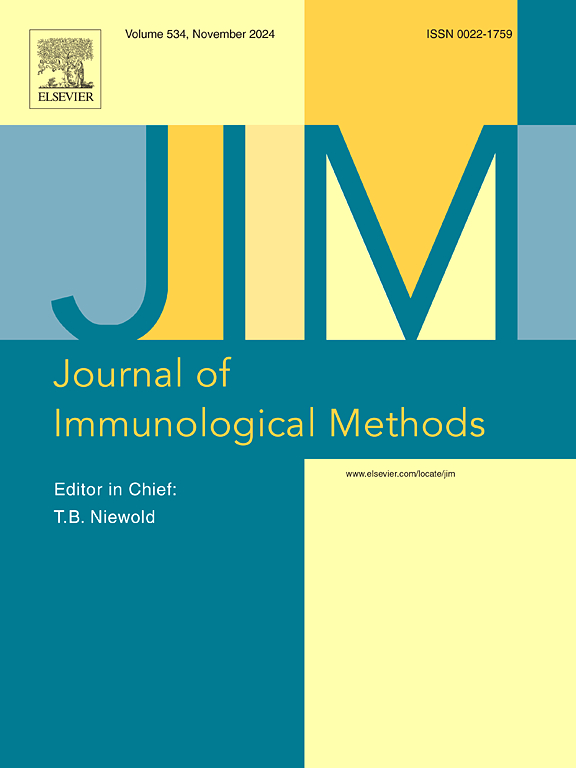禽蛋黄中的天然交叉反应抗 SARS-CoV-2 抗体
IF 1.6
4区 医学
Q4 BIOCHEMICAL RESEARCH METHODS
引用次数: 0
摘要
自21世纪初以来,冠状病毒家族在世界上引发了几次危及生命的疫情。严重急性呼吸综合征冠状病毒2 (SARS-CoV-2)是导致最新冠状病毒相关疫情的原因,仍然是全球主要的卫生问题。预防、诊断和治疗行动是缓解COVID-19大流行传播的最重要战略。在治疗方法中,特异性抗体在控制患者症状和防止他人感染方面起着至关重要的作用。本文介绍了禽类蛋黄作为交叉反应性抗sars - cov -2免疫球蛋白y的天然来源,采用ELISA、dot blot和western blot方法对不同种鸟蛋黄中的天然抗sars - cov -2免疫球蛋白y进行了鉴定。此外,还进行了生物信息学分析,以探讨这些天然抗体在蛋黄中存在的可能原因。印迹和酶联免疫吸附试验结果表明,蛋黄源性抗体能够识别和结合SARS-CoV-2的不同亚基。在蛋黄中还检测到大量浓度的针对SARS-CoV-2的中和抗体。此外,生物信息学分析显示传染性支气管炎病毒、SARS-CoV-2和其他冠状病毒科成员的成分结构相似。蛋黄似乎可以作为抗sars - cov -2抗体的天然、廉价和可获得的来源。鸟蛋黄衍生的抗sars - cov -2抗体具有多种诊断和治疗潜力。本文章由计算机程序翻译,如有差异,请以英文原文为准。
Natural cross-reactive anti-SARS-CoV-2 antibodies in avian egg yolk
Since the beginning of the 21st century, the Coronaviridiae family has caused several life-threatening outbreaks in the world. The severe acute respiratory syndrome coronavirus 2 (SARS-CoV-2), which is the cause of the latest Coronaviridiae-related outbreak, is still a major health issue worldwide. Prevention, diagnosis, and therapeutic actions are the most important strategies to mitigate the spread of the COVID-19 pandemic. Among therapeutics, specific antibodies play a crucial role in controlling the symptoms of patients and preventing others from becoming infected. Here, we have introduced the avian egg yolk as a natural source of cross-reactive anti-SARS-CoV-2 immunoglobulin Y. ELISA, dot blot and western blot were used to identify natural anti-SARS-CoV-2 IgY in the egg yolk of different species of birds. Also, bioinformatics analysis was performed to investigate the possible causes of the presence of these natural antibodies in the egg yolks. The results of blotting and ELISA assays demonstrated that the egg yolk-derived antibodies could identify and bind to the different subunits of SARS-CoV-2. Substantial concentrations of neutralizing antibodies against SARS-CoV-2 were also detected in the egg yolk. In addition, bioinformatics analysis showed structural similarities between the components of infectious bronchitis virus, SARS-CoV-2, and other members of the Coronaviridiae family. It seems that egg yolk can be used as a natural, inexpensive, and accessible source of anti-SARS-CoV-2 antibodies. Diverse diagnostic and therapeutic potentials for avian egg yolk-derived anti-SARS-CoV-2 antibodies are imagined.
求助全文
通过发布文献求助,成功后即可免费获取论文全文。
去求助
来源期刊
CiteScore
4.10
自引率
0.00%
发文量
120
审稿时长
3 months
期刊介绍:
The Journal of Immunological Methods is devoted to covering techniques for: (1) Quantitating and detecting antibodies and/or antigens. (2) Purifying immunoglobulins, lymphokines and other molecules of the immune system. (3) Isolating antigens and other substances important in immunological processes. (4) Labelling antigens and antibodies. (5) Localizing antigens and/or antibodies in tissues and cells. (6) Detecting, and fractionating immunocompetent cells. (7) Assaying for cellular immunity. (8) Documenting cell-cell interactions. (9) Initiating immunity and unresponsiveness. (10) Transplanting tissues. (11) Studying items closely related to immunity such as complement, reticuloendothelial system and others. (12) Molecular techniques for studying immune cells and their receptors. (13) Imaging of the immune system. (14) Methods for production or their fragments in eukaryotic and prokaryotic cells.
In addition the journal will publish articles on novel methods for analysing the organization, structure and expression of genes for immunologically important molecules such as immunoglobulins, T cell receptors and accessory molecules involved in antigen recognition, processing and presentation. Submitted full length manuscripts should describe new methods of broad applicability to immunology and not simply the application of an established method to a particular substance - although papers describing such applications may be considered for publication as a short Technical Note. Review articles will also be published by the Journal of Immunological Methods. In general these manuscripts are by solicitation however anyone interested in submitting a review can contact the Reviews Editor and provide an outline of the proposed review.

 求助内容:
求助内容: 应助结果提醒方式:
应助结果提醒方式:


